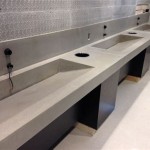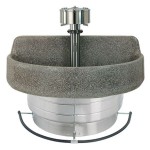Best Way to Refinish a Bathroom Vanity
Refinishing a bathroom vanity can significantly improve the aesthetic appeal of a bathroom without the expense and disruption of a full replacement. This process involves stripping away the existing finish, repairing any damage, and applying a new layer of paint or stain to revitalize the vanity's appearance. The "best" way to refinish a bathroom vanity depends on several factors, including the type of material the vanity is made from, the existing finish, the desired final look, and the skill level of the person undertaking the project. A carefully planned and executed approach will yield a durable and visually appealing result.
Before beginning any refinishing project, preparation is paramount. This includes a thorough assessment of the vanity's condition, gathering the necessary tools and materials, and adequately protecting the surrounding work area. Rushing into the refinishing process without proper preparation can lead to unsatisfactory results and potentially damage the vanity.
Assessment and Preparation: The Foundation of a Successful Refinishing Project
The initial step involves a comprehensive inspection of the vanity. Identify any areas with damage, such as scratches, dents, water stains, or peeling finish. Note the type of material the vanity is constructed from. Common materials include solid wood, plywood, MDF (Medium-Density Fiberboard), and laminate. The material will influence the choice of refinishing products and techniques.
Once the assessment is complete, gather the necessary tools and materials. These typically include: safety glasses, gloves, a dust mask, drop cloths, sandpaper (various grits), a sanding block or orbital sander, a scraper, a chemical stripper (if necessary), wood filler (for repairs), primer, paint or stain, a paintbrush or paint sprayer, a tack cloth, and clear sealant or topcoat.
Protect the bathroom from dust and spills by laying down drop cloths. Remove the vanity’s hardware (knobs, pulls, hinges) and store them in a safe place. Consider labeling the hardware to ensure proper reinstallation. If the sink and faucet are integrated into the vanity top, carefully disconnect them from the plumbing and remove the vanity top if possible. If removal is not feasible, protect the sink and faucet with plastic sheeting and painter's tape.
Stripping the Old Finish and Repairing Damage
Removing the existing finish is a crucial step in achieving a smooth and even surface for the new finish. The method used will depend on the type of finish present and the material of the vanity. Mechanical methods, such as sanding, are often preferred for lighter finishes and solid wood vanities. Chemical stripping may be necessary for stubborn or multiple layers of finish, or for vanities made of intricately detailed materials.
When sanding, start with a coarser grit sandpaper (e.g., 80-grit) to remove the bulk of the old finish. Progress to finer grits (e.g., 120-grit, 220-grit) to smooth the surface. Sand with the grain of the wood to avoid creating unsightly scratches. A sanding block or orbital sander can be used for larger, flat surfaces, while a sanding sponge can be helpful for reaching tight corners and edges. Regularly vacuum or wipe down the surface with a tack cloth to remove sanding dust.
If using a chemical stripper, follow the manufacturer's instructions carefully. Apply the stripper evenly to the surface and allow it to dwell for the recommended time. Use a scraper to remove the softened finish. Multiple applications may be necessary for thick or stubborn finishes. Neutralize the surface according to the stripper manufacturer's instructions before proceeding to the next step. Always work in a well-ventilated area when using chemical strippers and wear appropriate safety gear, including gloves, eye protection, and a respirator.
Once the old finish has been removed, address any damage to the vanity. Fill scratches, dents, and holes with wood filler. Allow the filler to dry completely and then sand it smooth with fine-grit sandpaper. For larger repairs, consider using wood epoxy, which provides greater strength and durability. If the vanity has water damage or rot, it may be necessary to replace the affected sections of wood. This may require advanced woodworking skills.
Applying the New Finish: Primer, Paint/Stain, and Topcoat
After the vanity surface is clean, smooth, and free of imperfections, the next step is to apply a primer. Primer is essential for creating a uniform surface for paint or stain to adhere to. It also helps to seal the wood, prevent bleed-through of tannins or stains, and improve the overall durability of the finish. Choose a primer that is compatible with the type of paint or stain you plan to use. Apply the primer in thin, even coats using a brush, roller, or paint sprayer. Allow the primer to dry completely according to the manufacturer's instructions, and then lightly sand it with fine-grit sandpaper to create a smooth surface for the paint or stain.
Select a high-quality paint or stain that is suitable for bathroom environments. Bathroom paint should be moisture-resistant and mildew-resistant to withstand the humidity and potential water exposure. Consider using a semi-gloss or gloss finish, as these are easier to clean than matte or flat finishes. For staining, choose a stain color that complements the overall aesthetic of the bathroom. Apply the paint or stain in thin, even coats, following the manufacturer's instructions. Multiple coats may be necessary to achieve the desired color and coverage. Allow each coat to dry completely before applying the next. Lightly sand between coats with fine-grit sandpaper to remove any imperfections and create a smooth surface.
Once the paint or stain has dried completely, apply a clear sealant or topcoat to protect the finish and enhance its durability. Choose a topcoat that is compatible with the paint or stain used. Polyurethane is a popular choice for bathroom vanities, as it provides excellent water resistance and durability. Apply the topcoat in thin, even coats, following the manufacturer's instructions. Multiple coats may be necessary to provide adequate protection. Allow each coat to dry completely before applying the next. Lightly sand between coats with fine-grit sandpaper to remove any imperfections and create a smooth surface.
After the final coat of topcoat has dried completely, allow the finish to cure for the recommended time before reinstalling the hardware and putting the vanity back into use. This allows the finish to fully harden and become more resistant to scratches and wear. Carefully reattach the hardware, ensuring that it is properly aligned and securely fastened. If the sink and faucet were removed, reconnect them to the plumbing and verify that there are no leaks.
Proper ventilation is crucial throughout the refinishing process, especially when using chemical strippers, primers, paints, stains, and topcoats. Work in a well-ventilated area or use a fan to circulate air. Wear a respirator to protect yourself from inhaling harmful fumes. Clean your brushes and paint trays thoroughly after each use. Dispose of used rags and other materials properly, following local regulations.
Consider the type of vanity handles and knobs to use after refinishing. Modern pulls and knobs can drastically change the look of the vanity, making it appear completely new. If the vanity is antique, ensure to use similar-styled handles. Hardware stores and online retailers offer a wide variety of styles and finishes to complement the refinished vanity. Remember to measure the size of the existing holes or be prepared to drill new ones.
For laminate vanities, the refinishing process differs slightly. Laminate surfaces cannot be sanded or stained like wood. Instead, they require a special bonding primer that is designed to adhere to smooth, non-porous surfaces. After applying the bonding primer, the vanity can be painted with a high-quality acrylic or latex paint. Several light coats are recommended. The key to success with laminate vanities is proper surface preparation and using the correct products designed for laminate surfaces.

How To Refinish Bathroom Cabinets Diy Domestic

How To Refinish A Bathroom Vanity Bower Power

How To Refinish Bathroom Vanity Top With Diy Resin Thediyplan

How To Refinish A Bathroom Vanity Bower Power

How To Refinish A Bathroom Vanity Naturally No Vocs Treasured Tips

How Can I Refinish My Bathroom Vanity Without Stripping Hometalk

How To Quickly Paint A Bathroom Vanity Cabinet Entri Ways

Paint Bathroom Vanity Countertop Sink So Easy A Piece Of Rainbow

How To Refinish Bathroom Vanity Top With Diy Resin Thediyplan

How To Paint Bathroom Cabinets Without Sanding 8 Vital Steps Grace In My Space
Related Posts







